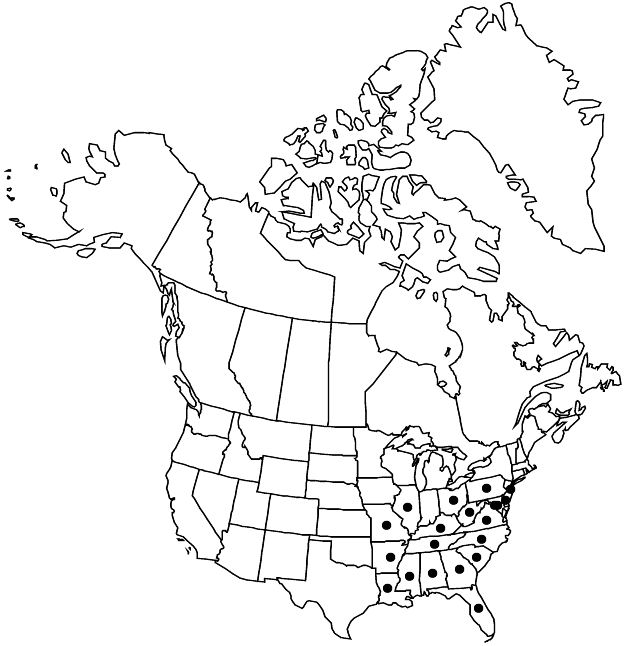Malus angustifolia
Fl. Bor.-Amer. 1: 292. 1803.
Trees, sometimes shrubs, 10–50(–100) dm. Stems 5–25 cm diam.; bark reddish brown to gray, longitudinally fissured with platelike scales; young branches reddish brown, sparsely puberulent, becoming gray or grayish brown, glabrescent; flowering shoots developing as short spurs or spiny thorns, (5–)10–40(–60) mm. Buds reddish brown, ovoid, 1.6 mm, scale margins tomentose. Leaves conduplicate in bud; heteromorphic; stipules deciduous, linear-lanceolate, 2–4(–5) mm, apex acuminate; vigorous shoot leaves: petiole (10–)15–25 mm, villous, sometimes tomentose; blade elliptic, oval, or ovate, sometimes triangular-ovate, (3.5–)4–6(–8) × (1.5–)3–4(–5) cm, base cuneate, sometimes rounded, margins sometimes slightly lobed, crenate, crenate-serrate, serrate, or entire, sometimes doubly serrate, apex rounded, broadly acute, sometimes apiculate, abaxial surface glabrous (villous only on veins), adaxial glabrous; flowering shoot leaves: petiole 3–10(–25) mm, villous, sometimes glabrous; blade elliptic or oblong, sometimes ovate, obovate, or lanceolate, (9–)15–50(–65) × (7–)10–20(–30) mm, base cuneate, sometimes rounded, margins unlobed, crenate, crenate-serrate, or entire, apex rounded (with point or acute), abaxial surface glabrous (veins villous), adaxial glabrous. Panicles corymblike; peduncles absent; bracteoles sometimes persistent, filiform, (1–)3–4(–6) mm. Pedicels (10–)20–30(–40) mm, glabrous, sometimes slightly villous. Flowers 20–30 mm diam.; hypanthium glabrous, rarely slightly villous; sepals triangular, (2–)3–4(–5) mm, equal to tube, apex acuminate, abaxial surface glabrous, adaxial hoary-tomentose; petals pink, sometimes fading white, oblong to narrowly obovate, (10–)12–16(–22) mm, claws (2–)3 mm, margins entire, sinuate, or fimbriate, apex rounded; stamens 20, (7–)9–12(–14) mm, anthers pink or rose before dehiscence; styles 5, connate basally, (6–)9–12(–15) mm, usually slightly longer than stamens, tomentose in proximal 1/3. Pomes green or yellow-green, subglobose, 10–20(–30) mm diam., cores not enclosed at apex; sepals persistent, erect; sclereids abundant surrounding core. Seeds dark brown. 2n = 34 (68).
Phenology: Flowering (Feb–)Mar–May; fruiting Aug–Sep.
Habitat: Open woods, thickets, hillsides, stream and lake banks, flood plains, terraces, roadsides, open fields, sandy soil, clay soil
Elevation: 10–700 m
Distribution

Ala., Ark., Del., D.C., Fla., Ga., Ill., Ky., La., Md., Miss., Mo., N.J., N.C., Ohio, Pa., S.C., Tenn., Va., W.Va.
Discussion
The attractive flowers of Malus angustifolia have a pleasant, violetlike odor.
Selected References
None.